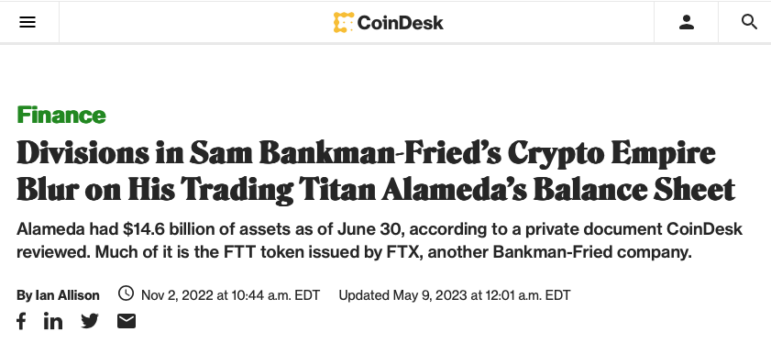
Image: Shutterstock
From Bitcoin’s inception to the “crypto winter” of late 2022, there has been a persistent question: does anyone understand cryto?
A lot of effort has gone into explaining it: media outlets from CNN to Forbes offer different versions of “Crypto 101” libraries: collections of resources created to help potential investors better understand the industry. Crypto companies and (seemingly solvent) crypto exchanges from Binance to Kraken do the same.
Journalist Matt Levine, who I interviewed for this paper, had the rare opportunity to produce an entire issue of Bloomberg Businessweek dedicated to crypto in October 2022. Every crypto reporter should read it.
Yet according to the Crypto Literacy Survey, a marketing tool created by industry group Cryptoliteracy.org, 91% of people don’t understand the basics of crypto.
Even for journalists who feel they have a good grasp on crypto technology and economics, covering the beat has been undeniably difficult. With over a decade of articles, videos, and podcasts in the rear-view mirror, now is a great time to reflect on some of the hard-learnt lessons of covering the industry.
I outline nine lessons in my paper, The Pickleball of Finance: Hard-Learnt Lessons in Covering Crypto, which you can download. Here, I summarize what I believe is the most important lesson for our trade: Ask more questions.
Avoiding Mistakes
In over a decade of covering crypto, journalists have made some serious unforced errors. Multiple sources I spoke to expressed frustration with journalists’ inability to get details right in articles, which led to a general distrust of all mainstream media coverage around crypto.
As CoinDesk reporter Sam Reynolds puts it, “No one has the Bible of crypto, right? We’re all learning.” Does this make covering crypto difficult? Absolutely. But, as legendary UCLA basketball coach John Wooden once said, “If you don’t have time to do it right, when will you have time to do it over?”
Perhaps the most infamous example of having to do it over in crypto involved The New York Times which, in February of 2022, published a piece by Kevin Roose titled Maybe There’s a Use Case for Crypto After All.
The story was about a company called Helium, a much-hyped “wireless network powered by cryptocurrency.” In it, Roose writes, “Anyone can use the Helium network, although most of its users so far are companies like Lime (which has used Helium to keep tabs on its connected scooters).”
Five months later, Mashable published an article about how Helium either lied about or distorted its relationships with Lime.
Following the Mashable piece, Helium removed the logos of both Lime and Salesforce from its homepage. Yet, as of this writing, the Times piece remains online as written, with the small exception of an embedded update from six months after the piece was published clarifying that, “Months after this column was published, some of Helium’s partnerships came under scrutiny from crypto skeptics who claimed that the company was claiming affiliations with companies it had no official deals with. A spokesperson for Lime said in an email that ‘beyond an initial test of its product in 2019, Lime has not had, and does not currently have, a relationship with Helium.’”
Balance Sheets

A CoinDesk reporter’s simple question led to the unraveling of the FTX cryptocurrency empire. Image: Screenshot, CoinDesk
A simple question asked by CoinDesk journalist Ian Allison — “What’s on your company’s balance sheet?” — led to the great unravelling of the onetime powerhouse FTX when Allison’s reporting revealed the liquidity of FTX’s sister company, Alameda Research, was tied largely to unbacked FTX tokens.
(There is speculation that Allison’s acquisition and subsequent publication of FTX’s balance sheet was driven by the business considerations of his outlet’s parent company, Digital Currency Group, which owns competing exchange Genesis, in which case the move may have backfired spectacularly.)
Most crypto companies, by virtue of incorporation jurisdiction and/or corporate setup, are not subject to the same reporting standards as companies in other industries. Thus, they can play around with assets in unique ways, as this 2021 Deloitte report found.
Interrogating balance sheets — such as they exist — is most crucial when it comes to companies promoting so-called “stablecoins.” These digital tokens peg their value to a reference asset, like the US dollar or gold. Because they are intended to facilitate transactions, they form much of the basis of the crypto economy.
In the fall of 2021, Bloomberg wisely investigated the claims of stablecoin company Tether, about which questions still abound.
What Can Crypto Do Better than Existing Systems?
On the other side of the coin, thoughtful questions have led to some of the most revealing crypto coverage. One question that’s proven reliable in cutting through crypto fog is some variation of “What can crypto do better than existing systems?”
This is what angel investor Zach Weinberg asked Web3 “investor” Packy McCormick on an episode of the Cartoon Avatars podcast, which elicited an ill-fated attempt at explaining how blockchain mortgages might work.
It’s also what author Stephen Dubner asked Web3 “investor” Arianna Simpson on an episode of the Freakonomics Radio podcast. Her answer (essentially, “we could use it to charge a neighbor to use our WiFi”) prompted his response: “Really? That’s the amazing blockchain future we’ve all been waiting for?”
Much of the crypto industry narrative has relied on tech utopianism, specifically the idea that crypto and blockchain technology will make many of aspects of our world somehow better, faster, less centralized, and/or more secure. If these promised improvements have not yet come to pass, it is worth asking: why not? Or, if they have, would they have been able to do so independently of the harm done to many retail investors?
Trolling
In addition to a lack of regulation, another reason it is imperative to doggedly question everything in the crypto space is the heightened culture of trolling that exists among “crypto bros.”
In the course of my work on this project, I was introduced to an individual who works in the crypto industry while running an active, anonymous Twitter account. This person bragged about lying to a Forbes journalist writing a piece about Caroline Ellison, the head of FTX’s sister hedge fund Alameda Research, who faced up to 110 years in prison for fraud before agreeing to cooperate with authorities.
The source said they made up several lies about Ellison that the journalist included in the final piece. “I trolled the journalist the whole time,” the source said, “because Forbes is notorious for being horrible.”
Trolling is deeply embedded in the crypto community because crypto is inextricable from the internet, where irony and trolling have become the lingua franca. And crypto was spawned, at least partially, from a distrust of authority. Some in cryptoland view journalists as arbiters of authority.
The source to whom I spoke called journalism “a very politically motivated fourth branch of government” and said the tenets of journalism go against crypto’s core tenets, which the source believes are “self-sovereignty,” “anti-establishment values,” and “going off the grid.”
Sometime after my first interview with the source, the Forbes story was updated with a correction that reads, in part: “An earlier version of this story included details noting that some alt-right leaning supporters of Ellison refer to her as ‘Queen Caroline.’ One source who confirmed those details now claims them to be false. They have been removed from the story, and the headline updated.”
The source was less than pleased with how Forbes dealt with the correction. “I think if you change the headline, that’s a pretty big deal, right?” the source said. “I feel like a little bit of a mea culpa would have been nice, something a little bit more [like], ‘Hey, we’re examining our reporting practices.’”
It’s Not Going Away
From the conversations I had while preparing this paper, one thing was abundantly clear: crypto is not going away.
As Decrypt’s editor-in-chief Dan Roberts put it: “There are thousands of shitcoins that probably will fail and go away. But what I’d say to people is that, at the very least, Bitcoin and Ethereum will still be here 10 years from now. I firmly believe that.”
Roberts, like many others in the industry, believes the latest crypto market crash is an example of growing pains. “These things come in waves,” he told me. “The mistake people make is the implication that a crash in crypto means the industry is dead. How many times have people declared crypto dead? It’s become a punchline.”
If crypto survives, the economics and technology surrounding it will likely change as the industry matures. This will necessitate close study by journalists to keep up with what is overstated or understated, real or fake.
Already, groups of journalists are coming together to form associations and establish best practices for crypto coverage in the future. The Association of Cryptocurrency Journalists and Researchers was founded in 2020 with the goal of fostering better crypto coverage. CoinDesk’s Reynolds currently serves as vice president.

The ACJR bills itself as the largest organization of professional cryptocurrency journalists and researchers in the world. Image: Screenshot, ACJR
Crypto journalist Cas Piancey of Protos and the podcast Crypto Critics Corner, speaking on a recent ACJR panel, said he would like to see a new crypto organization akin to the International Consortium of Investigative Journalists, where “you’re getting people with journalistic integrity, but also specialties in certain things, to be able to trace something throughout the world, and have people hone in on their specific skill set for these stories.”
Such a model would give crypto journalists the ability to work collaboratively on the kinds of longform pieces they don’t currently have time or money for.
This post was originally published by The Reuters Institute and is reprinted here with permission.
Additional Resources
Investigative Tips for Following the Cryptocurrency Trail
Tracking Illegal Funding Campaigns via Cryptocurrency
10 Tips for Tracking Russian-Owned Assets
 Brett Aresco recently graduated with honors from Columbia Journalism School, where he covered everything from the difficulty of securing polling places in New York City during the COVID-19 pandemic to Congress’ 12-year battle to pass the Corporate Transparency Act.
Brett Aresco recently graduated with honors from Columbia Journalism School, where he covered everything from the difficulty of securing polling places in New York City during the COVID-19 pandemic to Congress’ 12-year battle to pass the Corporate Transparency Act.
